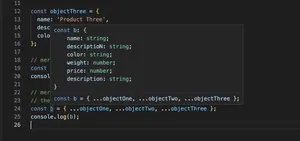Overview
Working with TypeScript can sometimes lead to the encounter of type-related errors that may not be obvious at first. One common error is the TypeScript error stating that an object literal may only specify known properties. This typically occurs when you’re trying to assign an object literal to a variable or parameter typed with an interface or type alias, and the object literal contains properties that haven’t been defined in that interface or type.
In this tutorial, we will explore the reasons behind this error and provide several solutions to fix it. These solutions will help to maintain type safety while also offering workarounds when you are dealing with dynamic properties.
Solution 1: Update TypeScript Interface
This solution involves adding the missing properties to the existing interface or type definition. This will ensure that the object literal conforms exactly to the interface or type expected.
Steps:
- Identify the property that is causing the error.
- Locate the interface or type declaration that is being used.
- Add the missing property to the interface or type.
- Ensure that all required properties meet the interface or type specifications.
Example:
interface KnownProperties {
knownProperty: string;
newProperty: number; // Add this line
t}
const myObject: KnownProperties = {
knownProperty: 'Known',
newProperty: 123 // This will no longer cause an error.
};
Advantages: This solution maintains type safety and makes the code self-documenting.
Limitations: It may result in verbose interfaces if there are many optional properties, and it’s not suitable when dealing with dynamic properties whose names are not known in advance.
Solution 2: Index Signatures
If you’re dealing with an object where property names are not known at design-time, you can use an index signature in your type or interface declaration. This allows any properties with certain types to be added to the object.
Steps:
- Define an interface with an index signature.
- Use this interface while declaring the variable.
Example:
interface FlexibleObject {
[key: string]: any; // Can use 'any' or a more specific type
t}
const myObject: FlexibleObject = {
knownProperty: 'Value',
anyOtherProperty: 123 // No error because of the index signature
};
Advantages: Offers great flexibility and is suitable for objects with dynamic keys.
Limitations: Can undermine type safety when misused, as it allows for any property to be added to the object.
Solution 3: Excess Property Checks Using Type Assertions
You can bypass the excess property checks by asserting the type of the object literal to the type you expect using ‘as’ keyword:
- Write the object literal.
- Assert the object literal type to match the interface or type.
Example:
interface KnownProperties {
knownProperty: string;
}
const myObject = {
knownProperty: 'Known',
extraProperty: true
} as KnownProperties;
Advantages: Quick fix for one-off cases or when the object conforms to the type other than the extra properties.
Limitations: It can be considered a type safety escape hatch and may conceal actual type errors.
Conclusion
Understanding the way TypeScript enforces type conformity is critical for developing robust applications. While encountering the ‘Object literal may only specify known properties’ error can be frustrating, each of the solutions provided brings you closer to resolving the issue in different scenarios. Updating interfaces ensures strict conformity, index signatures give flexibility with dynamic properties, and type assertions are a quick bypass for excess properties in specific situations.
